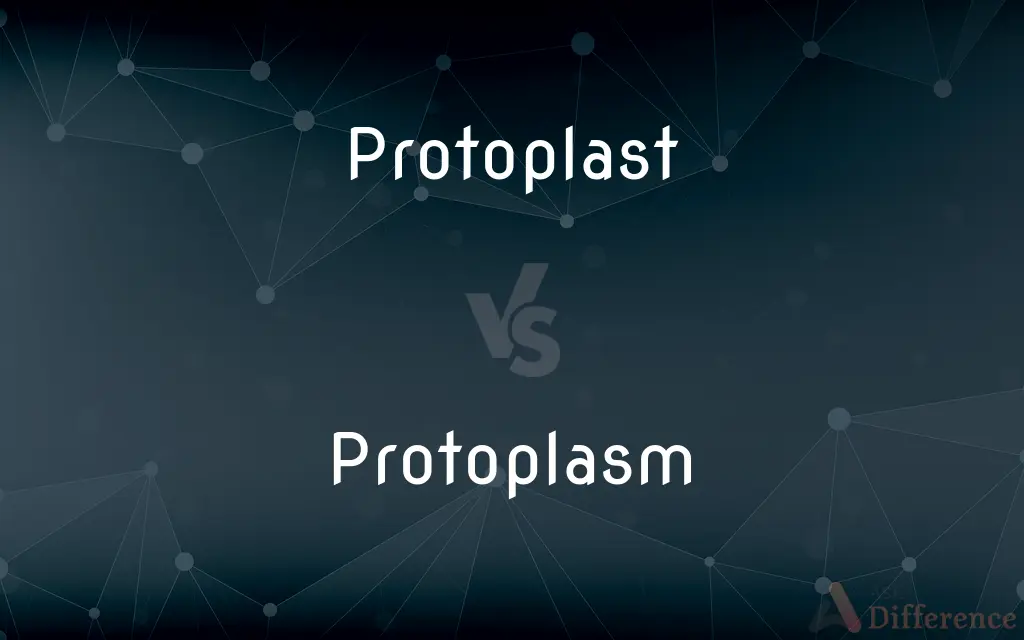Protoplast vs. Protoplasm — What's the Difference?
By Tayyaba Rehman — Updated on October 11, 2023
"Protoplast" refers to a cell without its cell wall, while "Protoplasm" is the living content inside the cell membrane, excluding the nucleus.

Difference Between Protoplast and Protoplasm
Table of Contents
ADVERTISEMENT
Key Differences
"Protoplast" specifically describes a cell that has had its cell wall removed, which can be achieved chemically or mechanically. In this condition, a plant cell becomes more fragile, lacking the protection and structural integrity provided by its cell wall. "Protoplasm," on the other hand, delineates the living part of a cell, encompassing all contents within the cell membrane, but excluding the nucleus.
The term "Protoplasm" is a bit older in the history of cell biology and once was thought to be the basic substance of life. It encompasses the cytoplasm and other organelles but doesn't include the nucleus. "Protoplast," meanwhile, is a more specific term, pointing to a state of the cell when its defining wall is absent, making it crucial in certain biotechnological applications.
Understanding the distinction between "Protoplast" and "Protoplasm" is essential in the realms of botany and cell biology. A "Protoplast" offers a unique perspective as it provides an opportunity to study the cell in a state without its typical outer barrier. "Protoplasm," however, reminds us of earlier scientific understandings when researchers were first discerning the complex nature of cell interiors.
When considering plant cells, the presence or absence of a cell wall is vital. The cell wall offers rigidity and structure. Therefore, a "Protoplast," being devoid of this wall, presents a vulnerable state. "Protoplasm," encompassing elements like the cytoplasm, offers a view into the dynamic, living contents of cells, laying the groundwork for understanding cellular functions and processes.
Comparison Chart
Definition
A cell without its cell wall
The living content of a cell excluding the nucleus
ADVERTISEMENT
Includes
Everything in a cell without the wall
Cytoplasm, organelles, but not the nucleus
Relation to Plants
Plant cell without its rigid wall
Living matter in plant and animal cells, except the nucleus
Historical Context
Specific term for cell without its defining barrier
Older term, once seen as the basic substance of life
Usage in Research
Studied for biotechnological applications
Used to understand basic cellular functions
Compare with Definitions
Protoplast
A tool in biotechnological studies due to its unique state.
Protoplast fusion is an important technique in genetic engineering.
Protoplasm
The jelly-like material inside the cell membrane.
The Protoplasm has a semi-fluid consistency.
Protoplast
Represents the cellular structure minus the rigid outer wall.
The Protoplast showed different behaviors than its walled counterpart.
Protoplasm
Includes cytoplasm and organelles but not the nucleus.
The organelles float within the Protoplasm of the cell.
Protoplast
A cell devoid of its cell wall.
The researcher isolated the Protoplast from the plant tissue.
Protoplasm
The basic substance once thought to be the essence of life.
Early scientists studied Protoplasm as the foundation of life.
Protoplast
Protoplast, from ancient Greek πρωτόπλαστος (prōtóplastos, "first-formed"), is a biological term coined by Hanstein in 1880 to refer to the entire cell, excluding the cell wall. Protoplasts can be generated by stripping the cell wall from plant, bacterial, or fungal cells by mechanical, chemical or enzymatic means.
Protoplasm
The living substance of a cell excluding the nucleus.
The Protoplasm is dynamic, teeming with activity.
Protoplast
A cell of a plant, fungus, bacterium, or archaeon from which the cell wall has been removed, leaving the protoplasm and plasma membrane.
Protoplasm
Protoplasm (/prəʊtə(ʊ)ˌplaz(ə)m/, plural protoplasms) is the living part of a cell that is surrounded by a plasma membrane. In some definitions, it is a general term for the cytoplasm (e.g., Mohl, 1846), but for others, it also includes the nucleoplasm (e.g., Strasburger, 1882).
Protoplast
(obsolete) Created first; archetypal.
Protoplasm
The complex, semifluid, translucent substance that constitutes the interior matter of a living cell and is composed of proteins, fats, and other molecules suspended in water. It includes the cytoplasm, the nucleus in eukaryotes, and organelles such as mitochondria.
Protoplast
The first-created human; Adam.
Protoplasm
(cytology) The entire contents of a cell comprising the nucleus and the cytoplasm. It is a semi-fluid, transparent substance which is the living matter of plant and animal cells.
Protoplast
(rare) A prototype or archetype; a model.
Protoplasm
The viscid and more or less granular material of vegetable and animal cells, possessed of vital properties by which the processes of nutrition, secretion, and growth go forward; the so-called " physical basis of life;" the original cell substance, cytoplasm, cytoblastema, bioplasm sarcode, etc.
Protoplast
The first person in a given family, lineage etc.; an ancestor.
Protoplasm
The living substance of a cell (including cytoplasm and nucleus)
Protoplast
(biology) The contents of a plant cell.
Protoplasm
The matrix that supports cellular life and functions.
Without Protoplasm, a cell wouldn't be able to carry out its functions.
Protoplast
The thing first formed; that of which there are subsequent copies or reproductions; the original.
Protoplast
A first-formed organized body; the first individual, or pair of individuals, of a species.
A species is a class of individuals, each of which is hypothetically considered to be the descendant of the same protoplast, or of the same pair of protoplasts.
Protoplast
A biological unit consisting of a nucleus and the body of cytoplasm with which it interacts
Protoplast
A plant cell in its vulnerable state without the outer barrier.
The Protoplast was more susceptible to external conditions.
Protoplast
A cell derived from plant, bacterium, or fungus by removing the cell wall.
The scientist treated the fungi to obtain its Protoplast.
Common Curiosities
What does a Protoplast lack compared to a regular plant cell?
A Protoplast lacks a cell wall.
Can Protoplasm be found in animal cells?
Yes, Protoplasm is the living content in both plant and animal cells, excluding the nucleus.
Does Protoplasm have a specific texture?
Yes, it typically has a semi-fluid, jelly-like consistency.
Which part of the cell is not included in the Protoplasm?
The nucleus is not part of the Protoplasm.
What happens to a cell when it becomes a Protoplast?
It loses its cell wall and becomes more vulnerable.
Is Protoplasm considered the basic substance of life?
Historically, it was once viewed as such, but now we understand cells in more detail.
Does Protoplasm include organelles?
Yes, Protoplasm includes the cytoplasm and organelles but excludes the nucleus.
Can Protoplasts regenerate their cell wall?
Yes, under suitable conditions, Protoplasts can regenerate their cell wall.
In what kind of organisms can you find Protoplasts?
Protoplasts can be derived from plants, bacteria, or fungi by removing the cell wall.
What's the primary difference between Protoplast and Protoplasm?
Protoplast refers to a cell without its wall, while Protoplasm denotes the living content inside a cell's membrane, excluding the nucleus.
How is Protoplasm different from cytoplasm?
Protoplasm includes cytoplasm and other organelles, but excludes the nucleus, while cytoplasm is just the material between the cell membrane and the nucleus.
How do Protoplasts relate to biotechnological studies?
They are often used in techniques like Protoplast fusion in genetic engineering.
Why might researchers want to create a Protoplast?
Protoplasts can be crucial for certain biotechnological and genetic engineering applications.
Why is Protoplasm often called the "physical basis of life"?
Because it contains most of the elements and compounds essential for the cell's life processes.
Share Your Discovery

Previous Comparison
Professional vs. Nonprofessional
Next Comparison
Haemoglobin vs. HemoglobinAuthor Spotlight
Written by
Tayyaba RehmanTayyaba Rehman is a distinguished writer, currently serving as a primary contributor to askdifference.com. As a researcher in semantics and etymology, Tayyaba's passion for the complexity of languages and their distinctions has found a perfect home on the platform. Tayyaba delves into the intricacies of language, distinguishing between commonly confused words and phrases, thereby providing clarity for readers worldwide.
















































